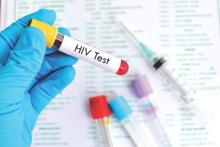A dual point-of-care test for syphilis and HIV performed well in a field trial, giving real-world data about a rapid and effective testing mechanism for two serious sexually transmitted infections (STIs).
A recent study detailing field testing results showed that the dual test was 100% specific for both syphilis and HIV, with sensitivity of 93.8% for the HIV antibody component and 81% for the Treponema pallidum antibody component.
Syphilis and HIV infections present a particular threat to certain high-risk groups, including sex workers, migrants, men who have sex with men, and pregnant women. “Coinfection is common, and syphilis may increase the risk of HIV acquisition and transmission,” wrote Claire Bristow, Ph.D., and her coauthors (Sex Trans Dis. 2015 Jan 16;43[1]:57-60. doi:10.1097/OLQ.0000000000000387). “Implementing an accurate, simple, and affordable dual screening strategy for HIV and syphilis could improve case finding and reduce time to treatment.”
Dr. Bristow, a postdoctoral fellow at the University of California, San Diego, and her colleagues shared findings from a study conducted in a Peruvian port town near Lima, targeting populations at high risk for HIV and syphilis. Outreach sites included transgender sex worker housing and a beauty salon. The participants, all adults, included sex workers, men who have sex with men, and transgender women.
The study compared the results from dual qualitative rapid immunoassays for serum antibodies to T. pallidum and HIV 1/2 (manufactured by Medmira Inc., Halifax, N.S., and dubbed the “Multiplo Rapid TP/HIV Antibody Test”) to reference serum laboratory testing of the same venipuncture sample. For T. pallidum, a particle agglutination test and rapid plasma reagin tests were performed. The HIV reference test was a fourth-generation enzyme immunoassay; all positive specimens also underwent a confirmatory Western blot test for HIV.
Of the 205 tests conducted, 174 were judged to be valid, meaning that the reagent control line for each test component was visible and complete. One further Multiplo test had an indeterminate (and therefore invalid) result for only the syphilis component of the test. Altogether, the Multiplo test yielded 15 positive results for HIV and 17 positive results for syphilis.
Concordance between the experimental Multiplo test and the reference HIV test was 0.97 calculated using Cohen kappa coefficient; one negative Multiplo result was positive using the reference test. The less sensitive Multiplo syphilis test achieved concordance of 0.88 with the reference test, with four samples found negative for syphilis with Multiplo testing returning a positive result on the reference assay.
Two trained staff members independently interpreted all test results, with 100% concordance. Dr. Bristow and her colleagues noted that though testing conditions were realistic overall, test results were interpreted by highly trained, highly motivated study investigators. Under investigation are optical readers that could give more reliable and easily interpreted results for the dual test, to help eliminate the possibility of haphazard interpretation.
In discussion, Dr. Bristow and her collaborators also noted the relatively high proportion of Multiplo tests that had invalid control lines, recommending improvement in control testing.
Citing the need for an easily-administered and easily-interpreted test for multiple STIs, Dr. Bristow and her colleagues urged more study and fine-tuning of this promising test. “Further research is warranted to determine how a dual test would perform and can be integrated into the flow of a busy sexual health clinic.”
The authors reported no conflicts of interest. The National Institute of Allergy and Infectious Diseases, National Institutes of Health, funded the study. All test materials were donated by Medmira Inc.
On Twitter @karioakes


